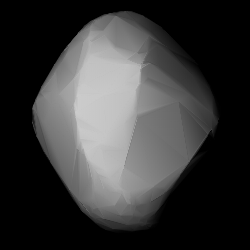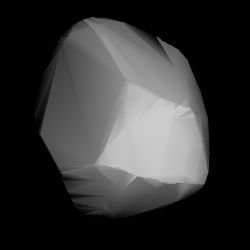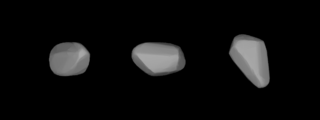Related Research Articles

212 Medea is a very large main-belt asteroid that was discovered by Johann Palisa on February 6, 1880, in Pola, and was named after Medea, a figure in Greek mythology.

217 Eudora is a large Main belt asteroid. It was discovered by French (Corsican) astronomer J. Coggia on August 30, 1880, in Marseilles, France. It was his fourth asteroid discovery and is named after Eudora, a Hyad in Greek mythology.

400 Ducrosa is a typical Main belt asteroid. It was discovered by Auguste Charlois on 15 March 1895 in Nice.

409 Aspasia is a large main-belt asteroid that was discovered by French astronomer Auguste Charlois on 9 December 1895 in Nice. It is classified as a CX-type asteroid.
481 Emita is a minor planet orbiting the Sun that was discovered by the Italian astronomer Luigi Carnera on February 12, 1902. The meaning of the asteroid's proper name remains unknown.
536 Merapi is a main belt asteroid orbiting the Sun. It was discovered by American astronomer George Henry Peters on May 11, 1904, from Washington, D.C.
554 Peraga is a minor planet orbiting the Sun that was discovered by German astronomer Paul Götz on January 8, 1905, from Heidelberg.
585 Bilkis is a minor planet, specifically an asteroid orbiting in the asteroid belt. It was discovered by German astronomer August Kopff in 1906 February and was given the Koran name for the Queen of Sheba. Photometric observations at the Palmer Divide Observatory in Colorado Springs, Colorado in 2006–7 were used to build a light curve for this object. The asteroid displayed a rotation period of 8.5742 ± 0.0005 hours and a brightness variation of 0.40 ± 0.02 in magnitude.
602 Marianna is a minor planet orbiting the Sun.
604 Tekmessa is a minor planet orbiting the Sun that was discovered by American astronomer Joel Hastings Metcalf on February 16, 1906. The name may have been inspired by the asteroid's provisional designation 1906 TK.

665 Sabine is a minor planet orbiting the Sun that was discovered by German astronomer Wilhelm Lorenz on July 22, 1908.
680 Genoveva is a minor planet orbiting the Sun. It was named after the play Genoveva by Friedrich Hebbel. The name may have been inspired by the asteroid's provisional designation 1909 GW, as W is pronounced 'v' in German, as is V in Latinate names such as 'Genoveva'.

690 Wratislavia is a minor planet orbiting the Sun. Wratislavia was discovered on October 16, 1909. IRAS data shows it is about 135 km in diameter.
739 Mandeville is a minor planet located in the asteroid belt. Its absolute magnitude is 8.50. It was discovered on 7 February 1913 by Joel Hastings Metcalf in Winchester, Massachusetts, and assigned the provisional code 1913 QR. A later, duplicate discovery was assigned the code 1963 HE.

747 Winchester is an asteroid, a minor planet orbiting the Sun. It was discovered in 1913, and is named after the town in which it was discovered, Winchester, Massachusetts, in the USA.
766 Moguntia is a minor planet orbiting the Sun. It was discovered on 29 September 1913 at Heidelberg by German astronomer Franz Kaiser, and is named after Mainz, ancient Moguntiacum. This object is a member of the same dynamic asteroid group as 221 Eos, the Eos family. It is orbiting at a distance of 3.02 AU from the Sun with a period of 5.24 years and an eccentricity (ovalness) of 0.097. The orbital plane is inclined at an angle of 10.1° to the plane of the ecliptic.

770 Bali is a minor planet orbiting the Sun. It is a member of the Flora family. It was discovered on 31 October 1913, by German astronomer Adam Massinger at the Heidelberg Observatory in southwest Germany. The asteroid was probably named after the Indonesian island of Bali, as the discoverer had named a couple other asteroids after places in Indonesia. The alternative hypothesis is that it was named after Bali, king of the Daityas in Hindu mythology.
774 Armor is a minor planet orbiting in the main belt. It was discovered on 13 December 1913, in Paris by French astronomer Charles le Morvan and was named after the Celtic region of Armorica. The asteroid is orbiting at a distance of 3.05 AU with a period of 5.32 yr and an eccentricity of 0.169. The orbital plane is inclined by an angle of 5.56° to the plane of the ecliptic.
854 Frostia is a main-belt asteroid orbiting the Sun. It was discovered in 1916 by Sergei Ivanovich Belyavsky from Simeiz Observatory in Crimea and is named after Edwin Brant Frost, an American astronomer. This asteroid measures approximately 8.4 km (5.2 mi) in diameter.
5656 Oldfield, provisional designation A920 TA, is a background asteroid from the inner regions of the asteroid belt, approximately 7.7 kilometers in diameter. It was discovered on 8 October 1920, by astronomer Walter Baade at the Bergedorf Observatory in Hamburg, Germany. The asteroid was named for English musician Mike Oldfield.
References
- 1 2 "769 Tatjana (1913 TA)". JPL Small-Body Database . NASA/Jet Propulsion Laboratory . Retrieved 5 May 2016.
- 1 2 3 Carry, B. (December 2012), "Density of asteroids", Planetary and Space Science, vol. 73, pp. 98–118, arXiv: 1203.4336 , Bibcode:2012P&SS...73...98C, doi:10.1016/j.pss.2012.03.009. See Table 1.
- ↑ Schmadel, Lutz D. Dictionary of Minor Planet Names. — Fifth Revised and Enlarged Edition. — B., Heidelberg, N. Y.: Springer, 2003. — P. 73. — ISBN 3-540-00238-3.